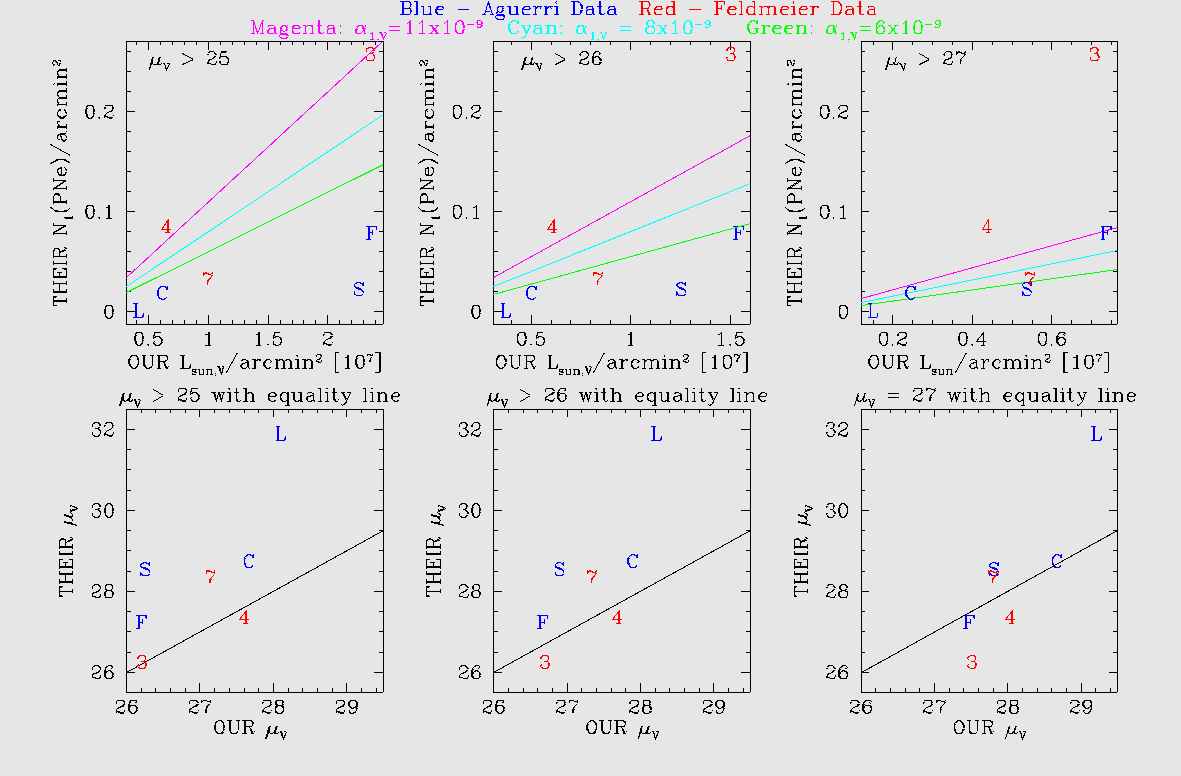
| Field |
N_ICPNe |
Area
(arcmin^2) |
ICPNe
/ arcmin^2 |
| Core |
17 |
943 |
0.018 |
| FCJ |
15 |
266 |
0.056 |
| LPC |
1 |
744 |
0.001 |
| SUB |
14 |
706 |
0.020 |
| Field |
N_27.0 (Extrapolated) |
Estimated
Number of Contaminants |
N_ICPNe col_2 - col_3 |
Area (arcmin^2) |
ICPNe
/ arcmin^2 |
| 3(h) |
21 |
4.6 |
16 |
241 |
0.06639 |
| 4 |
21 |
3.0 |
18 |
158 |
0.11392 |
| 7 |
44 |
21 |
23 |
1098 |
0.02095 |
| Field |
Luminosity(bol) (10^9 L_Sun) |
N_1.0/arcmin^2 |
| 3(h) |
9.0 |
0.20614 |
| 4 |
2.4 |
0.08386 |
| 7 |
6.5 |
0.03268 |
| Field |
fractional
estimate of galaxy coverage |
Their
results N_1(PNe)/arcmin^2 |
Corrected
results N_1(PNe)/arcmin^2 [used for plots] |
| Core |
0.05 |
0.01803 |
0.01893 |
| FCJ |
0.15 | 0.01983 |
0.0228 |
| LPC |
0.00 | 0.00134 |
0.00134 |
| SUB |
0.40 | 0.05639 |
0.07895 |
| 3(h) |
0.25 |
0.20614 |
0.2577 |
| 4 |
0.02 |
0.08386 |
0.08554 |
| 7 |
0.05 |
0.03268 |
0.03268 |
| Field |
Average
Counts |
Luminosity
Density [used for plots] |
Median
Counts |
|||||||
| u>25 |
u>26 |
u>27 |
u>25 |
u>26 |
u>27 |
u>25 |
u>26 |
u>27 |
||
| Core |
4.108 |
3.342 |
1.629 |
0.6162 |
0.5013 |
0.2444 |
3.276 |
3.096 |
2.068 |
|
| FCJ |
15.78 |
10.28 |
4.907 |
2.367 |
1.542 |
0.5368 |
13.190 |
10.125 |
5.402 |
|
| LPC |
2.759 |
2.479 |
0.9944 |
0.4139 |
0.3719 |
0.1492 |
2.552 |
2.477 |
1.523 |
|
| SUB |
15.06 |
8.359 |
3.579 |
2.259 |
1.254 |
0.5368 |
11.442 |
8.312 |
4.194 |
|
| 3(h) |
15.71 |
10.02 |
4.716 |
2.356 |
1.503 |
0.7074 |
12.975 |
9.934 |
5.205 |
|
| 4 |
4.340 |
4.044 |
2.913 |
0.651 |
0.6066 |
0.4369 |
3.832 |
3.769 |
3.113 |
|
| 7 |
6.647 |
5.564 |
3.637 |
0.997 |
0.8346 |
0.5455 |
5.417 |
5.191 |
3.930 |
|
| Field |
mu_V |
| 3(h) |
26.5 |
| 4 |
27.4 |
| 7 |
28.4 |
| Field |
mu_B |
mu_V |
| Core |
29.8 |
28.8 |
| FCJ |
28.6 |
27.6 |
| LPC |
32.9 |
31.9 |
| SUB |
29.7 |
28.7 |
| Field |
fractional
estimate of galaxy coverage |
Their
results mu_V |
Corrected
results mu_V [used for plots] |
| Core |
0.05 |
28.8 |
28.75 |
| FCJ |
0.15 | 27.6 |
27.23 |
| LPC |
0.00 | 31.9 |
31.90 |
| SUB |
0.40 | 28.7 |
28.55 |
| 3(h) |
0.25 |
26.5 |
26.26 |
| 4 |
0.02 |
27.4 |
27.38 |
| 7 |
0.05 |
28.4 |
28.35 |
| Field |
Median
value |
Surface Brightness (median) |
Mean value |
Surface Brightness (mean) [used for plots] |
|||||||||||||
| u>25 |
u>26 |
u>27 |
u>25 |
u>26 |
u>27 |
u>25 |
u>25.5 |
u>26 |
u>26.5 |
u>27 |
u>25 |
u>25.5 | u>26 |
u>26.5 | u>27 |
||
| Core |
3.276 |
3.096 |
2.068 |
27.91 |
27.97 |
28.41 |
4.108 |
3.759 |
3.342 |
2.671 |
1.629 |
27.67 |
27.76 |
27.89 |
28.13 |
28.67 |
|
| FCJ |
13.190 |
10.125 |
5.402 |
26.40 |
26.69 |
27.37 |
15.78 |
13.25 |
10.28 |
7.527 |
4.907 |
26.20 |
26.39 |
26.67 |
27.01 |
27.47 |
|
| LPC |
2.552 |
2.477 |
1.523 |
28.18 |
28.22 |
28.74 |
2.759 |
2.671 |
2.479 |
2.011 |
0.9944 |
28.10 |
28.13 |
28.21 |
28.44 |
29.21 |
|
| SUB |
11.442 |
8.312 |
4.194 |
26.55 |
26.90 |
27.64 |
15.06 |
11.05 |
8.359 |
5.991 |
3.579 |
26.26 |
26.59 |
26.89 |
27.26 |
27.82 |
|
| 3(h) |
12.975 |
9.934 |
5.205 |
26.42 |
26.71 |
27.41 |
15.71 |
13.03 |
10.02 |
7.334 |
4.716 |
26.21 |
26.41 |
26.70 |
27.04 |
27.52 |
|
| 4 |
3.832 |
3.769 |
3.113 |
27.74 |
27.76 |
27.97 |
4.340 |
4.249 |
4.044 |
3.695 |
2.913 |
27.61 |
27.63 |
27.68 |
27.78 |
28.04 |
|
| /7 |
5.417 |
5.191 |
3.930 |
27.37 |
27.41 |
27.71 |
6.647 |
6.103 |
5.564 |
4.872 |
3.637 |
27.14 |
27.24 |
27.32 |
27.48 |
27.8 |
|